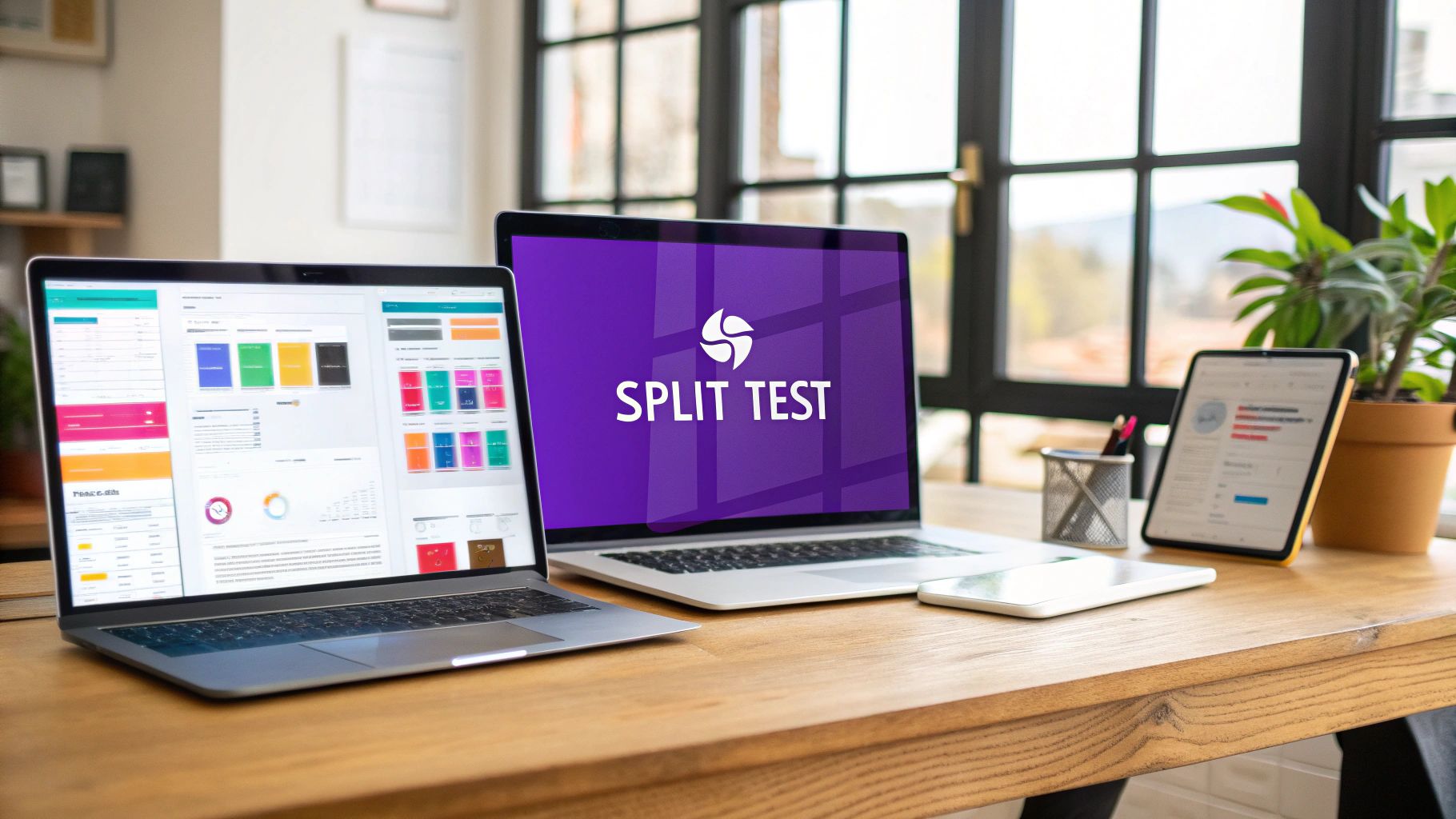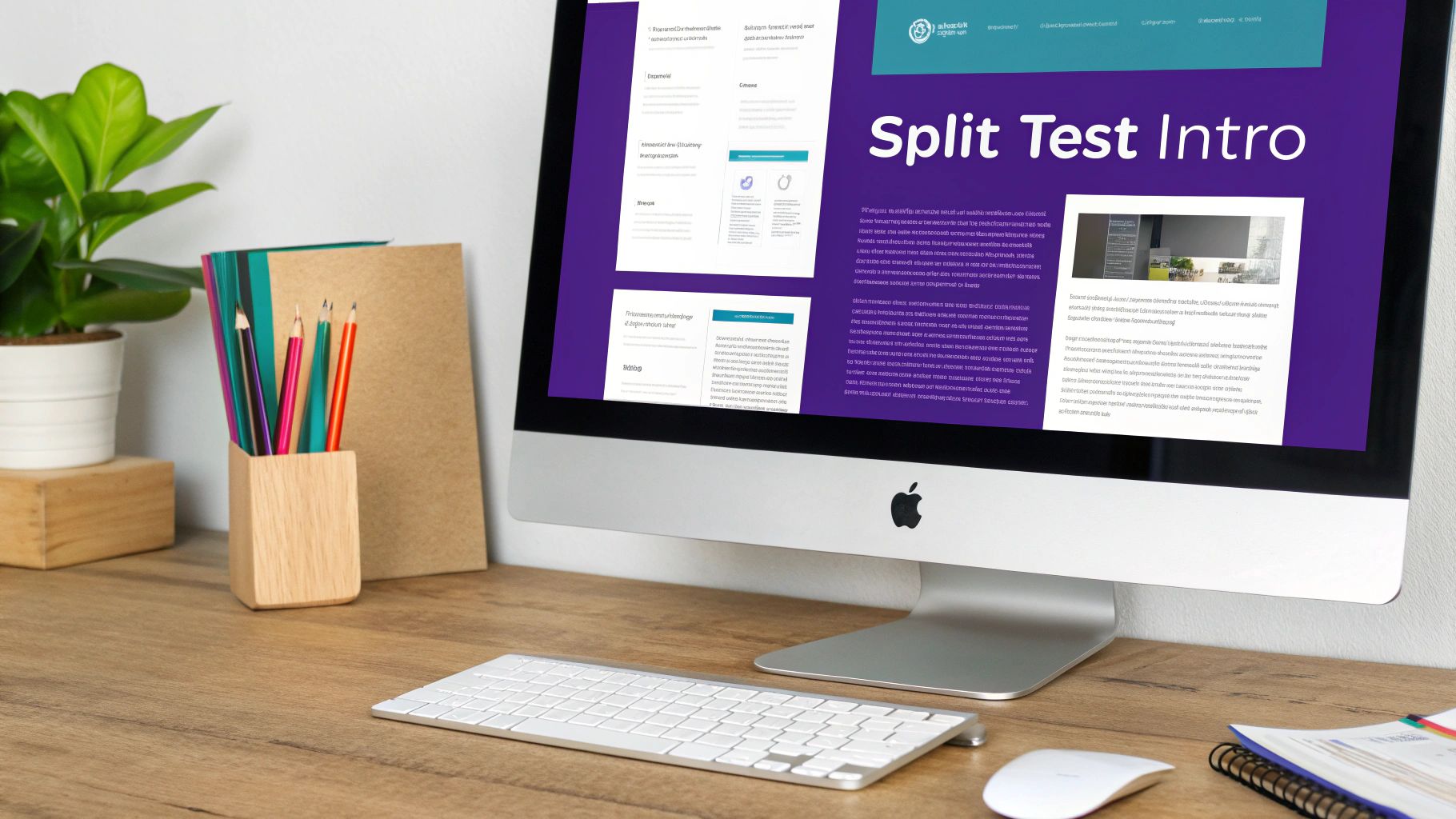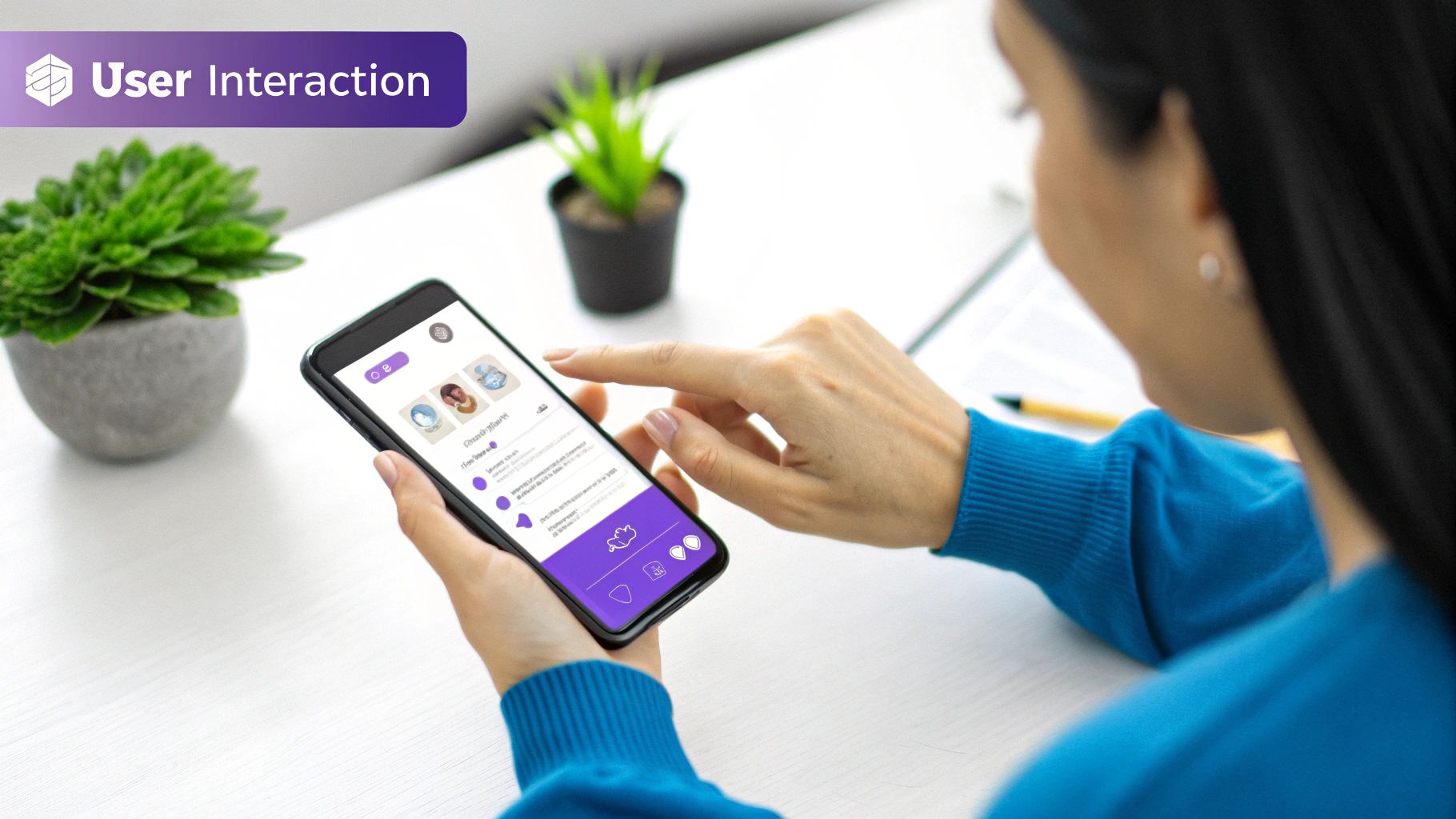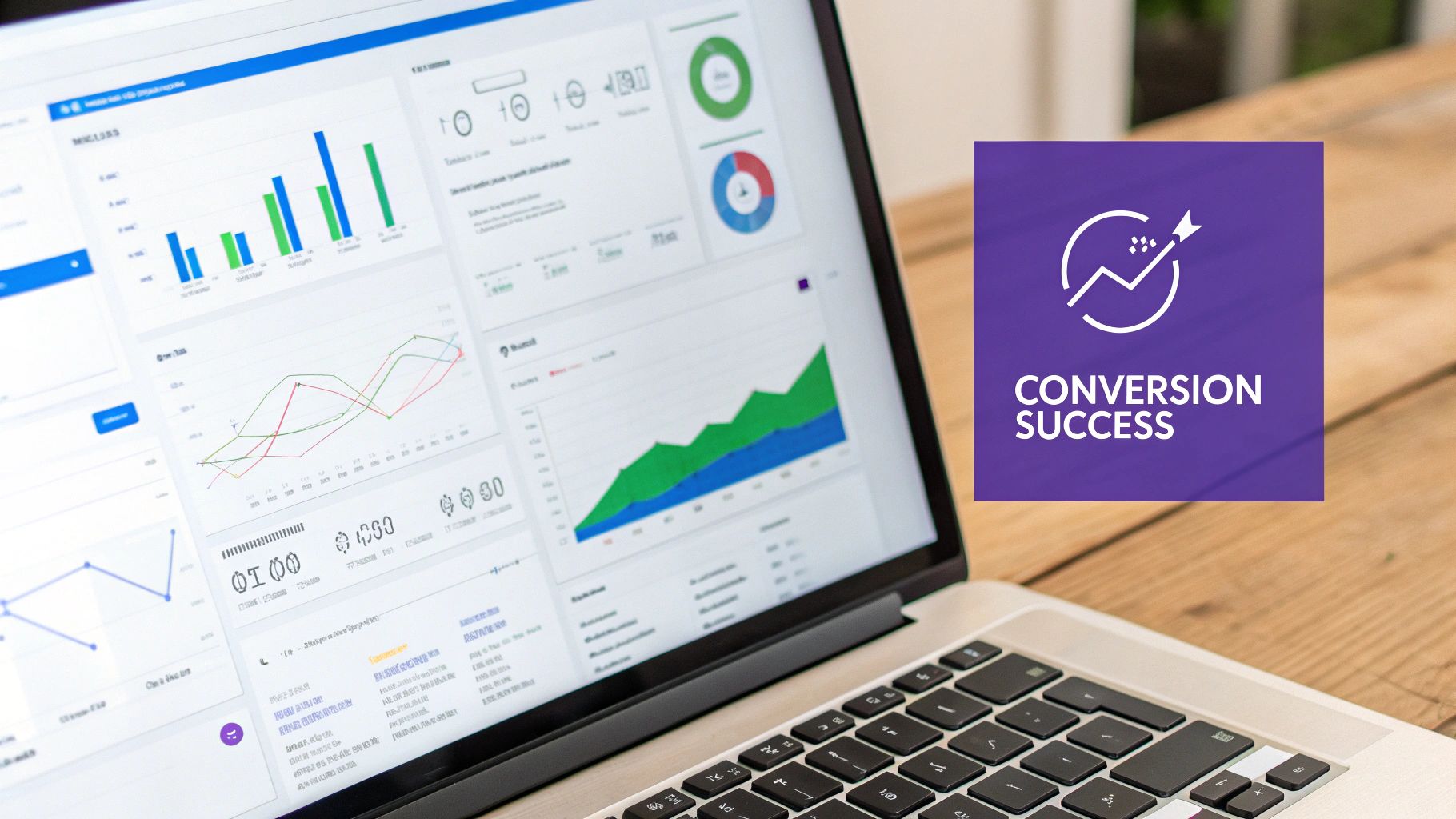Boost Conversions with Split Test Landing Pages

Understanding the Science Behind Split Testing

Split testing, also known as A/B testing, is essential for optimizing landing pages. It takes the guesswork out of design and uses data to improve conversions. Think of it as a science experiment for your website, where you constantly test different variations to see what works best.
The Core Principles of Effective A/B Testing
This methodical approach relies on a few key principles. You begin with a control, which is your current landing page. Then, you create a variation (or multiple variations) where you change one element, such as the headline, call to action, or image. Isolating changes helps pinpoint what impacts performance.
For example, imagine testing two headlines. You'd keep everything else the same – images, body copy, and form fields – and change only the headline. This lets you directly compare how each headline affects visitor behavior. Interestingly, about 60% of companies use A/B testing on their landing pages to boost conversion rates. For more A/B testing statistics, check out this resource: https://99firms.com/blog/ab-testing-statistics/
Why Data-Driven Optimization Wins
This data-driven approach helps you understand what your audience likes and what makes them convert. Instead of relying on intuition or guesswork, you use real data to make decisions. This means you can continuously improve your landing pages and boost performance over time.
Statistical Significance and Testing Duration
Running your split tests long enough to achieve statistical significance is important. This ensures that the changes in performance aren't random but are directly related to your modifications. Think of it like flipping a coin. A small sample size might show heads more often, but a larger sample size gets closer to a 50/50 split.
This same principle applies to landing page tests. The longer you test and the more data you collect, the more confident you can be in the results. Robust data allows you to implement changes that improve your conversion rates over the long haul.
High-Impact Elements Worth Testing First

When it comes to boosting conversions on your landing page, not all elements are created equal. Sure, every little detail adds to the overall user experience, but some have a much bigger impact than others. To get the most bang for your buck, focus your split testing efforts on these high-impact elements first. This means identifying the parts of your page that consistently deliver the best ROI when tested.
Headlines and Value Propositions
Your headline is often the first thing visitors see, so even tiny changes can significantly influence their perception of your product or service. Testing different headlines is vital to find out which ones truly resonate with your target audience. Just as important is clearly communicating your value proposition – what makes your offering special and beneficial. Experiment with different phrasing, lengths, and placement of your value proposition to see how you can maximize user engagement.
Calls to Action (CTAs)
Think of your call to action as the bridge between a visitor and a customer. This crucial element guides users towards your desired conversion goal, whether it's buying a product, signing up for a newsletter, or requesting a demo. Testing variations in your CTA button color, text, size, and placement can significantly affect click-through rates. For example, swapping a passive phrase like "Submit" for something more action-oriented like "Get My Free Quote" can do wonders for your conversions. A/B testing with tools like Optimizely is a proven way to improve these rates. Studies show that roughly 60% of businesses see a rise in conversion rates after using A/B testing. Even better, a well-tested and improved UX design can boost conversions by as much as 400%. Want to learn more? Find more detailed statistics here.
Images and Videos
Visuals are incredibly powerful for grabbing attention and conveying information quickly. Testing different images or videos in your hero section, product showcases, or testimonials can have a big impact. This might involve experimenting with different image styles, video lengths, or even trying photographs versus illustrations. See what resonates best with your audience through A/B testing.
Form Fields and Layout
Long, complicated forms can be a major turn-off for potential customers. Simplifying your forms, reducing required fields, and optimizing the layout can make the process much smoother. Even seemingly small tweaks like rearranging form fields or adding clear labels can make a surprising difference.
Social Proof and Trust Signals
Building trust is essential for conversions. Adding social proof elements like testimonials, reviews, or client logos can significantly increase visitor confidence. Testing the placement and format of these trust signals will help you pinpoint what works best for your target audience.
Prioritizing Your Split Test Landing Pages Strategy
While all these elements are important, you'll want to prioritize your testing based on potential impact and your landing page's goals. Begin with the elements most likely to sway conversions, such as headlines and CTAs. Then, systematically work through the other elements, continuously testing and refining your page for optimal performance. The key is to create variations that provide useful data without being so drastically different that they alienate your core audience.
To help you prioritize, here’s a handy table summarizing the potential impact and implementation difficulty of various landing page elements:
To help you strategize your testing efforts, take a look at this table:
High-Impact Landing Page Elements to Test: This table compares landing page elements based on their potential impact on conversions and how difficult they are to implement.
As you can see, headlines and CTAs offer the most significant potential for improvement with relatively low implementation effort, making them excellent starting points. Images and videos, while impactful, might require more effort. Form fields and layout changes are easier to implement but might have a moderate impact. Finally, social proof, while important, tends to have a lower impact and can be addressed later. By focusing on the elements with the highest potential and lowest effort, you can quickly identify areas for improvement and boost your landing page conversions effectively.
Choosing the Right Testing Tools for Your Reality

Picking the perfect tools for split testing landing pages can be a bit of a puzzle. So many options, each claiming to be the ultimate conversion booster. But the real trick is to look past the hype and find the features that actually fit your business. This means thinking about your team's skills, budget, and how comfortable you are with testing in general.
Matching Tools to Your Needs
The best tool isn’t always the fanciest. If you're a smaller business or just starting out with split testing, a simpler platform like Google Optimize might be a great fit. It's free and works well with Google Analytics, making it an easy way to dip your toes into A/B testing. You can experiment with different landing page versions without breaking the bank.
For larger businesses with bigger budgets and more advanced testing needs, platforms like Optimizely and VWO (Visual Website Optimizer) offer more powerful features. These include things like multivariate testing, advanced segmentation, and personalization. But these extras come with a steeper learning curve and a higher price tag. Make sure your team has the time and know-how to actually use these advanced features. Paying for features you don't use is a waste of money and can make things more complicated than they need to be.
Unbounce is another excellent option for businesses focusing on landing page optimization. This platform is all about creating and testing landing pages. It simplifies the process of building, publishing, and analyzing different versions. Unbounce offers a user-friendly interface and provides templates and tools specifically for landing page optimization.
Interestingly, about 44% of businesses use dedicated split testing software for their experiments. These tools, including options like Crazy Egg, Optimizely, and VWO, have robust features for running multiple tests at once and creating automatic reports. This helps streamline landing page optimization and pinpoint areas for improvement. Want to learn more? Find more detailed statistics here.
To help you compare some of these popular tools, we've put together a handy table:
Split Testing Tool Comparison
Detailed comparison of top split testing platforms by features, pricing, and ideal use cases
This table gives a quick overview of some popular split testing tools. Remember to research each tool further to determine which best aligns with your specific needs and budget.
Integrating With Your Existing Tech Stack
Choosing a tool that works smoothly with your current technology is crucial. If your website is built on a platform like Shopify, you'll want a tool that integrates seamlessly. This ensures efficient data transfer and avoids compatibility headaches. Look for tools that offer plugins or integrations with your CRM, analytics platforms, and email marketing software. Good integration means less manual work and a more streamlined workflow.
Automation and Actionable Insights
Effective split testing isn’t just about running tests—it's about getting useful insights and using them. Find tools that automate tedious tasks like creating variations and collecting data. This lets your team focus on analysis and strategy. Even more important, your tool should provide clear, actionable insights. Avoid platforms that bury you in data without telling you what to do with it. The right tool will present data visually and highlight key takeaways, making it easy to spot winning variations and make changes that boost conversions.
Balancing Cost and Value
Finally, think about the cost of each tool compared to its value. Free tools like Google Optimize are a great starting point, but they may not have all the bells and whistles. Paid tools offer more advanced features, but it's important to weigh the benefits against the price. Look closely at your budget and testing needs to find a tool that offers the right mix of features and affordability.
Building a Testing Framework That Actually Works

Moving beyond simple A/B testing requires a structured approach. This systematic framework ensures your split test landing pages deliver reliable, actionable data you can use to improve conversions. Successful optimization teams build their testing programs on a strong foundation, starting with a clear understanding of their goals.
Identifying Opportunities and Formulating Hypotheses
Before making changes, pinpoint areas for improvement. Analyzing user behavior data through tools like heatmaps or scrollmaps helps highlight where visitors struggle or leave.
For example, if visitors rarely scroll down to your product details, it might indicate a problem with page layout or above-the-fold content. This analysis helps develop a hypothesis, a testable statement about expected outcomes.
Establishing Control Groups and Sample Sizes
A proper control group is essential. This group sees the original landing page, acting as the baseline against which variations are measured. Equally important is an appropriate sample size.
Enough traffic to each variation ensures statistical significance, meaning results reflect real differences, not random chance. It's like taste-testing—you need enough people to try it for accurate feedback.
Connecting Tests to Measurable Outcomes
Split testing should always connect to business objectives. Decide what you want: more leads, increased sales, or higher average order value. These specific goals determine which metrics to track.
For more leads, track form submissions. For increased sales, monitor transactions and revenue. These measurable outcomes provide direction and purpose.
Testing One Variable at a Time
Avoid changing multiple elements simultaneously. Changing one variable at a time, like a headline or button color, provides clear insights. This isolates each change's impact, making it easy to understand what drives improvements (or hurts performance).
Testing multiple elements at once makes it nearly impossible to pinpoint the cause of changes. It's like changing several cake ingredients and then guessing which one affected the taste most.
Determining Optimal Test Duration and Statistical Significance
How long should a split test run? While there's no universal answer, sufficient duration is crucial for statistical significance. This ensures results aren't due to random fluctuations.
Two weeks is a good starting point. Factors like traffic volume and expected impact influence the ideal duration. Statistical significance tools within your split testing platform can help determine when you have enough data. HubSpot offers further insights on this.
Building a Culture of Continuous Improvement
These principles shift you from sporadic testing to continuous improvement. Systematic testing provides data to continually refine landing pages and drive conversions. This disciplined approach creates high-performing pages with consistent results.
Finally, document your findings! This builds valuable knowledge, informing future tests and preventing repeated mistakes. A robust testing framework ensures long-term success for your split test landing pages program.
Avoiding Testing Mistakes That Waste Your Time
Even seasoned e-commerce pros can stumble into common split testing traps. These mistakes can range from simple oversights to complex analytical errors, undermining results and wasting precious resources. By understanding these pitfalls, you can protect your testing program from misleading results and steer clear of the wrong path. This means avoiding costly implementation errors and maximizing key optimization opportunities.
The Danger of Premature Conclusions
One of the most common mistakes is ending a split test too early. It's tempting to declare a winner as soon as one variation gains a slight lead. But early data can be deceptive. Think of flipping a coin ten times and getting heads seven times. Does this signify a biased coin? Not necessarily. Just as you need more coin flips, your split test landing pages need sufficient traffic for reliable results. Make sure your tests run long enough to achieve statistical significance, proving the changes are real and not due to random chance.
Beware of Confirmation Bias
Confirmation bias, our tendency to favor information supporting pre-existing beliefs, can skew test interpretation. If you expect a change to boost conversions, you might interpret mixed results as positive. This can lead to implementing changes that actually harm performance. Avoid this by setting clear, measurable goals before starting the test and adhering to pre-determined evaluation criteria. Focus on the data, not your gut feeling.
Cross-Device Compatibility: A Critical Oversight
In our mobile-centric world, ignoring cross-device compatibility is a major blunder. A winning variation on desktop might flop on mobile, or vice versa. Always test your split test landing pages across different devices and screen sizes for consistent user experience. A visually appealing design on a large screen could be cluttered and confusing on a smaller one, leading to lower mobile conversions even if the desktop version performs well.
Sample Pollution and Improper Segmentation
Sample pollution, where users accidentally see multiple variations, can corrupt data. This happens if your testing tool isn't set up correctly or if users clear their cookies mid-test. Likewise, improper segmentation can mislead. If you're testing a change aimed at new customers but include returning customers in your test, the results won't accurately reflect the change's impact on your target group. Ensure your tests are correctly configured and your audience is segmented appropriately.
The Pitfalls of Simultaneous Testing
Running multiple tests simultaneously on the same page creates conflicts and muddies the data. Changes from one test can influence the results of another, making it difficult to isolate individual impacts. It’s like trying to gauge the effectiveness of two fertilizers by using both on the same plant. You can't tell which fertilizer contributed more to the growth. Instead, run tests sequentially, focusing on one element at a time for clearer, actionable insights.
By avoiding these common pitfalls, your split test landing pages will deliver dependable results, enabling informed decisions and maximizing e-commerce conversions. This translates directly into improved performance and higher revenue. A well-executed testing strategy is the key to unlocking your online store’s full potential.
Taking Your Testing Program to the Next Level
Once you’ve mastered split testing landing pages, you can unlock even greater optimization potential. How? By incorporating more advanced techniques! These strategies help you dig deeper into user behavior and find opportunities you might miss with basic A/B testing. It's all about going beyond simple changes and exploring how different elements interact and how various user segments respond.
Multivariate Testing: Uncovering Element Interactions
A/B testing compares two versions of a page. Multivariate testing (MVT), on the other hand, tests multiple variations of several elements simultaneously. Think of it this way: if you’re testing headlines and button colors, with A/B testing you might create two headlines and two button colors, resulting in four variations. MVT lets you test all possible combinations of those elements.
This gives you a much better understanding of which elements perform best, and more importantly, which combinations are most effective. Ultimately, MVT provides valuable insights into how elements interact to influence user behavior.
Sequential Testing: Building on Previous Learnings
Sequential testing uses a step-by-step approach. Instead of starting from scratch with each test, you use previous results to inform the next round. For example, if a test reveals a winning headline, you’d then incorporate that headline into your next test focusing on call-to-action buttons.
This allows you to continually refine your page based on cumulative data, gradually optimizing towards peak performance. It’s like building with blocks—each successful test adds another layer of improvement.
Segmentation: Tailoring to Specific User Groups
Segmentation analyzes how different user groups respond to the same changes. Perhaps a new landing page layout works well with new visitors, but not returning customers. By segmenting your audience, you can identify these nuances and personalize the experience.
You can test different versions of your landing page based on demographics, purchase history, or referral source. This allows you to optimize for each segment, ensuring the most relevant message reaches the right people.
Dynamic Content, Personalization, and Machine Learning
With dynamic content, you can display personalized content to different segments in real-time, tailoring the experience based on individual characteristics and preferences. Machine learning takes this personalization even further, automatically optimizing content based on user behavior. Machine learning algorithms analyze large datasets to identify patterns and predict what content will resonate with different segments, helping you scale your efforts and constantly refine your approach.
Creating a Comprehensive Testing Roadmap
Finally, a structured testing roadmap is essential. This plan should align with your business objectives and include clear timelines and success metrics. It should encompass planned tests, hypotheses, target segments, and key performance indicators (KPIs).
Building this institutional knowledge makes your testing program increasingly valuable over time. Each test informs the next, creating a continuous improvement cycle and boosting conversions. Remember to document all test results—both successes and failures—creating a resource for future tests and preventing repeated mistakes. Through consistent, strategic testing, you can drive sustainable growth and maximize the potential of your landing pages.
Turning Test Victories Into Lasting Results
Split testing landing pages isn't a one-time deal. The real value comes after a winning variation is found. This is where individual wins become lasting conversion improvements. It's about more than just implementing the winning version. It requires documentation, implementation, and long-term performance monitoring. Think of it as building a house: the split test is the blueprint, but you still have to build the actual structure.
Communicating Wins and Building a Knowledge Base
Sharing split test results with stakeholders is essential. Clearly presenting the data, including the conversion uplift and the specific changes, demonstrates the value of your testing efforts. Imagine a concise report showing how a simple call-to-action tweak led to a 15% increase in click-through rates. This justifies the testing time and encourages buy-in for future optimization initiatives.
Documenting your findings, both wins and losses, creates a valuable knowledge base. This prevents repeating past mistakes and informs future tests, accelerating your optimization process. It's like a recipe book: successes are new dishes, and failures teach you what to avoid next time.
Prioritizing Future Tests for Maximum Impact
Let your test results guide future optimization efforts. Prioritize tests based on potential impact, implementation complexity, and alignment with business goals. For example, if a test reveals your value proposition isn't connecting with your audience, prioritize tests focused on refining your messaging and positioning.
Consider ease of implementation, too. A small change with high potential impact should take priority over a complex change with a potentially smaller impact. This strategic prioritization maximizes the return on your testing efforts and ensures continuous improvement. It's like tending a garden: focus on the high-yield, low-maintenance plants first.
Implementing Winning Variations and Monitoring Performance
Proper implementation of winning variations is critical. Thoroughly quality assure the changes to ensure they function seamlessly across all devices and browsers. Think of launching a new product feature – you wouldn't release it without rigorous testing. Similarly, a winning landing page variation needs thorough testing for flawless execution.
Once implemented, monitor performance closely. Track key metrics like conversion rates, bounce rates, and average order value to confirm sustained improvements. Long-term monitoring is vital because user behavior changes. What works today might not work as effectively tomorrow. This requires ongoing data analysis and iterative testing to maintain peak performance. Think of it like regular car maintenance: it ensures smooth running and prevents future problems.
Expanding Your Testing Program Across the Customer Journey
Don't confine split testing to landing pages. Extend this data-driven approach to other customer journey touchpoints, like email marketing campaigns, product pages, or even the checkout process. By systematically testing and optimizing these touchpoints, you create a cohesive and effective customer experience that drives conversions at every stage. Think of it as optimizing a sales funnel: each stage must be fine-tuned for maximum overall flow. This holistic approach creates a continuous improvement cycle, leading to substantial gains in conversions and business growth.
Ready to transform your e-commerce business and boost conversions? Wand Websites offers expert website design and optimization services to help you succeed. Visit Wand Websites today to learn more!


